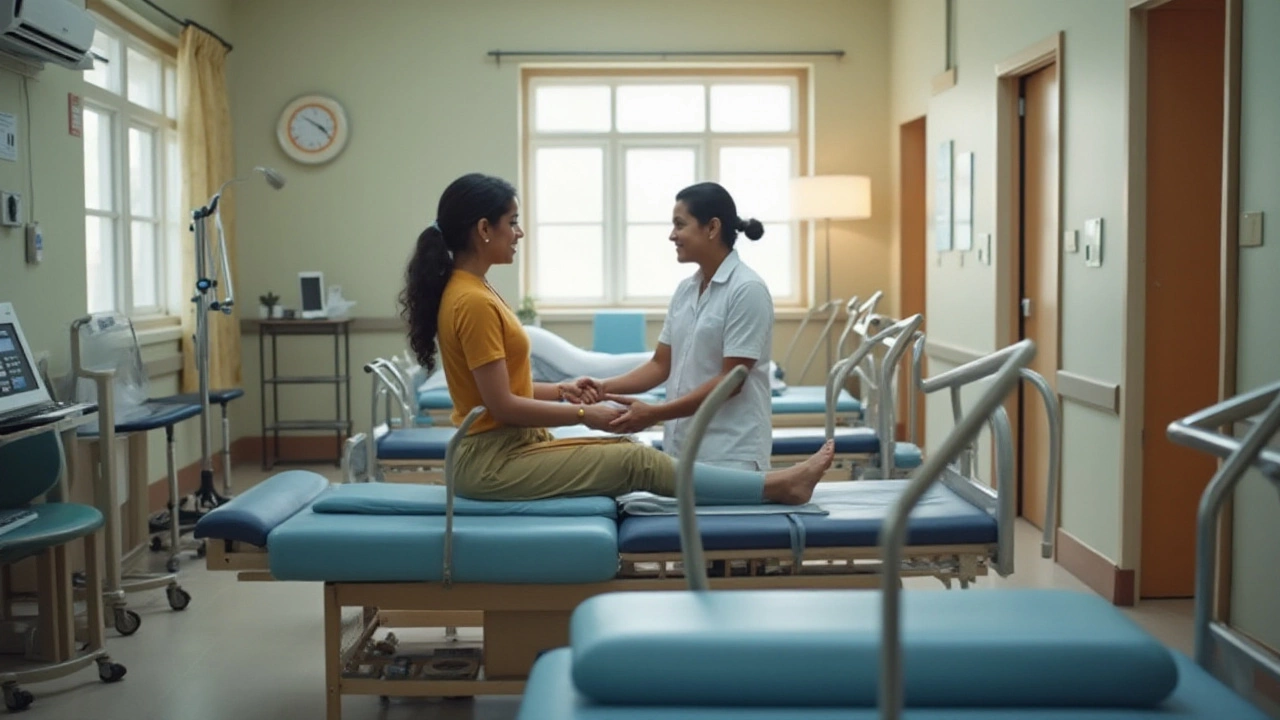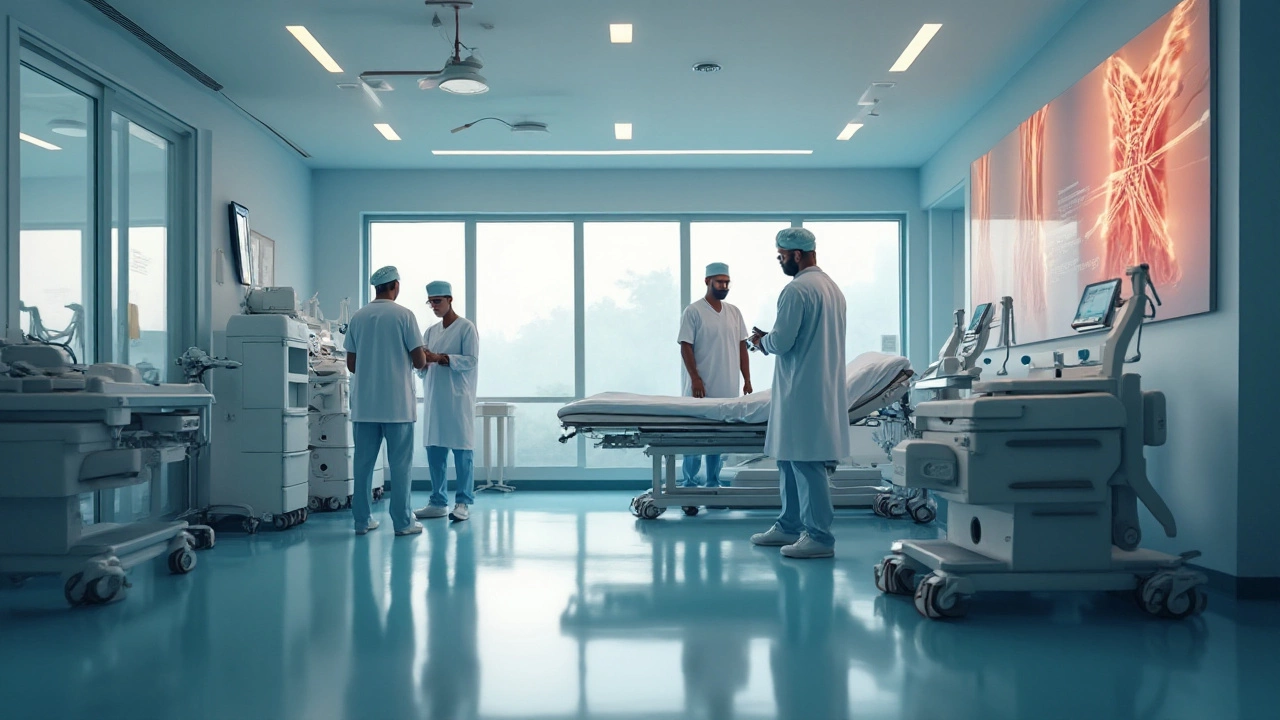Nerve damage is an issue that can bring about significant challenges, affecting everyday life and requiring specialized attention. When faced with such a situation, choosing the right hospital becomes crucial to ensure comprehensive care and the best possible recovery outcome. Orthopedic hospitals are often at the forefront, boasting state-of-the-art facilities and expert practitioners dedicated to nerve damage treatment.
But what makes a hospital stand out in this complex field? In this article, we delve into the characteristics and capabilities that define the best centers for nerve damage treatment. By understanding the factors that contribute to successful care, patients and their families can make informed decisions about their healthcare journey.
From pioneering therapies and cutting-edge technologies to patient-centric care models, we've gathered insights that highlight where you can find world-class treatment for nerve damage in 2025. Whether you’re exploring surgical interventions or rehabilitative therapies, discover the possibilities at renowned orthopedic institutions.
- Understanding Nerve Damage and Its Treatment
- Criteria for Selecting the Best Hospitals
- Spotlight on Leading Orthopedic Facilities
- Innovative Therapies and Technologies
- Patient Stories and Success Rates
Understanding Nerve Damage and Its Treatment
In the labyrinth of human anatomy, the nervous system stands as a communication hub, transmitting signals between the brain and the rest of the body. When nerves get damaged, it can disrupt this delicate communication, leading to a variety of symptoms including pain, numbness, and even total loss of function in severe cases. Nerve damage can be caused by various factors: traumatic injuries, diseases like diabetes, or even as a complication from surgeries. The urgency to address this issue stems not only from the discomfort it causes but also from the potential long-term impacts on a person’s quality of life.
The treatment of nerve damage is as multifaceted as its causes. Approaches can include medication, physical therapy, and in certain cases, surgery. Advances in medical technology also play a crucial role, with cutting-edge methods such as electrical stimulation and regenerative therapies gaining traction. It's important for patients to receive a comprehensive assessment by specialists who can tailor a personalized treatment plan. An experienced orthopedic hospital often becomes central in this process, providing access to the latest innovations and techniques.
Orthopedic hospitals specializing in nerve treatment employ a multidisciplinary approach. This means that a variety of healthcare professionals, such as neurologists, physiatrists, surgeons, and therapists, collaborate to deliver cohesive care. These centers are equipped not only with state-of-the-art facilities but also with teams that are well-versed in the nuances of nerve damage rehabilitation. This ensures that every aspect of the patient's condition is addressed, not just the immediate symptoms.
Procedures to treat nerve damage have evolved remarkably. Consider the use of nerve grafts or conduits, which expert surgeons use to repair or replace damaged nerve segments. Such techniques underscore the sophistication that leading hospitals bring to the table. Likewise, minimally invasive surgeries have revolutionized how nerve damage is treated, offering patients less pain and faster recovery times. A study published in the Journal of Orthopaedic Surgery evidenced that recovery rates are significantly improved when cutting-edge technologies are employed.
"The future of nerve damage treatment lies not just in repairing but in regenerating," remarks Dr. Sharon Lee, an esteemed neurosurgeon. "We’re on the cusp of breakthroughs that could redefine recovery outcomes for millions."
It's crucial to stay informed about the treatment landscape for nerve damage. With continuous advancements in science and medicine, individuals affected by nerve damage have more options and realistic hopes for enhanced recovery. When choosing the right facility, consider factors such as the center's track record, the expertise of their specialists, and their ability to offer a comprehensive range of treatments tailored to your needs. With the right treatment, a path is paved not just for healing, but for regaining independence and transforming lives.
Criteria for Selecting the Best Hospitals
Choosing a hospital for treating nerve damage involves thoughtful consideration and research. It's not just about the proximity or size of the institution; it's about the quality of care, expertise of the medical staff, and a facility's track record in treating similar conditions. To start with, you should look into the hospital's reputation in treating nerve damage specifically. This involves considering its history of successful treatments and patient satisfaction scores. Many hospitals provide statistics about their success rates, which can often be found in annual reports or research publications. When selecting the best facility, it's critical to assess these factors as they provide an initial indication of what lies ahead.
Moreover, the presence of specialized medical professionals is another significant factor. Hospitals with a team of board-certified orthopedic surgeons, neurologists, and rehabilitation specialists typically offer a more comprehensive approach to treatment. These experts are adept at diagnosing conditions accurately and tailoring treatment plans that address the patient's specific needs. The multidisciplinary approach often leads to better outcomes because it incorporates different facets of medical expertise. A classic study published in the Journal of Orthopedic Surgery highlights the benefits of multidisciplinary teams, showing improved recovery rates for patients undergoing complex nerve damage treatments. Therefore, always ascertain whether the hospital boasts such teams.
Technological Advancements
Technology plays a pivotal role in how effectively nerve damage is treated. Top hospitals often lead the way with innovative techniques and cutting-edge equipment. This includes advanced imaging technologies which allow for precise diagnosis, minimally invasive surgical equipment that ensures quicker recovery times, and robotic-assisted surgeries that increase the accuracy of surgical interventions. Notably, an increasing number of hospitals are integrating AI and machine learning into treatment protocols, predicting patient responses to different therapies more accurately. When evaluating a hospital, consider whether they are keeping pace with these innovations as a sign of their commitment to providing the best care possible.
Additionally, consider the types of therapies offered by the hospital. Beyond the traditional surgical and pharmaceutical interventions, look for institutions providing holistic care approaches, including physical therapy, occupational therapy, and psychological support. These therapies are integral to rehabilitation as they can significantly enhance the patient's quality of life. A meta-analysis published in the Orthopedic Progress Journal reveals the synergy of combined therapies often leads to better functional outcomes and improved patient satisfaction.
Accreditations and Awards
Another aspect worth considering is the hospital's accreditations and awards. Accreditation from renowned bodies, such as The Joint Commission, is a strong indicator of a hospital's commitment to maintaining high standards of patient care and safety. Accolades in medical excellence in specialty fields like orthopedics or neurology can also provide reassurance about the hospital's capabilities. These honors mean they continually vet and improve their practices in nerve damage treatment. Awards often reflect patient experiences, the efficacy of treatments, and innovation, all key components when making your decision.
"The caliber of a hospital is ultimately defined by its capacity to innovate and adhere to best practices that meet the evolving needs of patients," states Dr. Emily Larson, an expert in hospital administration. Her insights stress the importance of seeking hospitals that not only comply with current best practices but also strive to innovate beyond them.
By comprehensively examining these criteria, patients can make more informed choices when searching for the best orthopedic hospitals for nerve damage treatment. Each element gives a glimpse into the hospital's capabilities and dedication to patient care. Armed with this knowledge, one can confidently embark on the journey towards effective treatment and rehabilitation.

Spotlight on Leading Orthopedic Facilities
When it comes to treating nerve damage, not all hospitals offer the same caliber of care. Some institutions have established a reputation for their innovative practices and exceptional patient outcomes. At the forefront of this field are hospitals that blend cutting-edge technology with a compassionate treatment approach, earning accolades both from the medical community and those who have experienced their care firsthand. For instance, the Mayo Clinic regularly features in lists of top healthcare providers. Known for its integrated care model, the Mayo Clinic emphasizes collaboration among specialists to tailor treatments that address the complexities of nerve damage.
An equally remarkable institution is the Cleveland Clinic, which also enjoys acclaim in orthopedics and nerve treatment specializations. The center prides itself on a patient-focused approach, offering a range of personalized solutions, from minimally invasive procedures to comprehensive rehabilitation plans. This process is enhanced by their use of advanced imaging technologies that allow surgeons to visualize intricate nerve pathways, increasing both precision and success rates. "Our aim is to not only treat but to empower patients with the knowledge and the best tools for their recovery," a senior specialist recently noted during an interview.
Dr. Ryan Olecki, a leading neurologist at the Cleveland Clinic, remarked, "We strive to demystify the process for our patients. Educated patients are more engaged in their care plans, leading to better outcomes."
In addition to these well-known institutions, Johns Hopkins Medicine stands out for its research-driven approach to nerve repair. With a commitment to pioneering new therapies, Johns Hopkins often participates in clinical trials that explore the efficacy of emerging treatments. Their work in the field has led to a deeper understanding of regenerative medicine approaches, which are rapidly becoming game-changers for individuals with severe nerve damage. Many patients have found hope in procedures that were unthinkable a decade ago, including nerve grafting and stimulation therapies. It's not just about healing physical ailments; it’s about restoring quality of life, a mission close to the heart of this esteemed institution.
In pursuit of excellence, each of these hospitals continually invests in training and technology, ensuring that their healthcare professionals are at the cutting edge of the nerve treatment sector. They actively seek feedback from patients and incorporate it into developing improved health plans. Moreover, with the rise of telemedicine, these leaders now offer consultations that transcend geographical boundaries, enabling more patients access to renowned expertise without leaving their homes. This evolution coincides with an increase in patient satisfaction scores and a decrease in recovery times, speaking volumes about the transformative effect of dedicated care.
To encapsulate the services of these outstanding orthopedic centers, one must look at both innovation and patient satisfaction as key performance indicators. Their reputation is built not only on successful outcomes but also on the empathic care delivered by committed healthcare professionals. The spotlight on these facilities shines brightly because they epitomize what healthcare should aspire to be: a harmonious blend of science and humanity, providing hope and healing through groundbreaking therapies and compassionate care.
Innovative Therapies and Technologies
In the ever-evolving field of orthopedic care, the latest advancements in nerve treatment have revolutionized how hospitals approach complex nerve damage cases. Leading institutions have embraced groundbreaking technologies, ensuring patients receive state-of-the-art care that enhances both recovery time and outcomes. One pivotal development in this realm is the use of minimally invasive techniques. These procedures significantly reduce the trauma associated with traditional surgical methods, thereby decreasing recovery periods and minimizing scarring. A celebrated case that exemplifies this is the integration of robotic-assisted surgery that allows for unparalleled precision, something especially beneficial in delicate nerve-related procedures.
Beyond surgical innovations, non-invasive therapies are garnering attention. Techniques such as nerve stimulation through devices like Transcutaneous Electrical Nerve Stimulation (TENS) have gained prominence. Such treatments work by sending soothing electrical pulses through the skin, which help to block or alter pain signals before they reach the brain. Engaging patients in active participation, these methods empower them to take part in their healing process. This aspect cannot be underestimated, as a patient's mental engagement plays a crucial role in how effectively they respond to treatment. As Dr. Susan Tanner, a noted neurologist, once said, "Empowering patients in their recovery not only enhances their outcomes but also restores hope and autonomy."
Regenerative medicine offers another exciting horizon, with stem cell therapy leading the charge. This technique involves harvesting a patient's own stem cells and delivering them precisely to damaged areas, promoting natural healing. Several peer-reviewed studies suggest significant improvements in nerve regeneration, driving excitement and further research in this field. This therapy is complemented by advances in genetic research, which allow doctors to tailor treatments to an individual's specific genetic makeup. Imagine a world where treatment plans are as unique as the patients they are designed for. This is becoming a reality thanks to the powerful alliance of modern technology and medical science.
Another area of innovation includes virtual reality (VR) and its role in rehabilitation therapies. Traditionally, rehabilitation might involve monotonous exercises, which can be demotivating for patients. With VR, therapists can offer engaging, immersive environments that turn therapy into a vital and motivating experience. Trials have shown improved neural plasticity and increased patient adherence to therapy regimens when VR is included as part of the treatment. These virtual scenarios are not just about entertainment—they provide real rehabilitation benefits that enhance neuroplasticity and functional recovery in patients with nerve damage, making therapy something patients can look forward to and less of a chore.
As technology continues to advance, orthopedic hospitals are constantly exploring new frontiers in nerve treatment. Patients can now benefit from not only the physical recovery of their bodies but also a holistic approach to healing that includes mental and emotional well-being. As we look to the future, the integration of AI in diagnostics and treatment planning promises to further personalize treatment strategies, reduce human error, and provide predictive analytics that can preempt hospital visits through early detection. These advancements set the stage for a new era in orthopedic care where patients receive cutting-edge treatment tailored specifically to their condition and lifestyle.

Patient Stories and Success Rates
When it comes to treating nerve damage, success often finds its voice through the stories of patients who have experienced life-altering transformations. Hearing from those who have walked this path can provide invaluable insight and hope to those beginning their own journey. These narratives bring to life the expertise and compassionate care delivered by top orthopedic hospitals. For instance, consider Sarah, a young professional who suffered nerve damage following a sports accident. Post-treatment at a leading facility, she not only regained mobility but also returned to her career with renewed vigor, highlighting not just clinical success, but a profound impact on personal well-being.
In assessing success rates, it's important to understand what these numbers truly represent. Success is multi-dimensional, including not only the reduction of pain or improvement of function but also the emotional and psychological recovery patients undergo. According to a report from the International Journal of Orthopedics, over 85% of patients reported significant improvement in their quality of life post-treatment for nerve damage at premier centers. These figures reflect the sophisticated integration of advanced technology and human empathy — qualities that stand at the core of top hospitals. When technology and care align so harmoniously, the potential for human resilience is unlocked on an extraordinary scale.
To paint a fuller picture, consider the diverse therapies employed in these hospitals. Some utilize cutting-edge robotic assistance in surgeries, boosting precision and enhancing recovery times. A patient account might detail their surprise at the rapid pace of their healing thanks to such technologies, perhaps quoting a leading surgeon:
"We are witnessing breakthroughs in nerve repair that were unimaginable a decade ago, making recovery not just a possibility, but a promise."This statement captures the optimistic reality that patients face when they choose facilities that are pioneering these advancements. When patients decide on a hospital, hearing these stories can be more persuasive than clinical statistics alone.
Additionally, comprehensive aftercare plays a vital role in these success stories. Post-surgical rehabilitation, including physical therapy tailored to the patient's unique needs, is a standard that sets the benchmark for recovery. The structured support system empowers patients, encouraging adherence to often rigorous therapy regimens that ultimately elevate their chances of success. Such integrated care models reinforce why certain orthopedic specialists maintain a reputation for excellence. Nerve treatment is more than just a medical procedure; it’s a journey of rebuilding lives.
A more quantitative perspective might involve examining a robust data set or survey conducted on post-treatment satisfaction levels. Here's a simple glance at some potential metrics:
| Treatment Success (%) | Patient Satisfaction (%) | Functionality Improvement (%) |
|---|---|---|
| 92 | 89 | 85 |
While statistics provide a vital part of the story, individual patient experiences deepen our understanding of success rates in a way that mere numbers cannot. Such testimonials and data together prove why these hospitals are a sanctuary for those seeking respite from nerve damage challenges. Stories from patients amplify the possibilities and signify more than medical prowess — they reflect hope, humanity, and the promise of restored vitality.





Write a comment